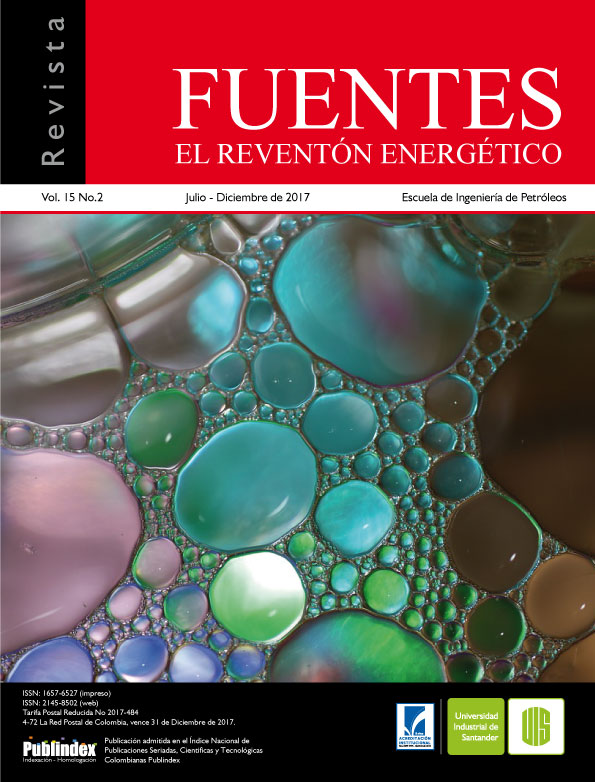Pressure and pressure derivative analysis for asymmetry finite-conductivity fractured vertical wells
Publicado 2017-12-15
Palavras-chave
- Fracture Conductivity,,
- Transient Pressure Analysis,
- TDS Technique,
- Fractured Wells
Como Citar
Resumo
Many researchers have developed equations to characterize hydraulic fractures assuming they are symmetrical with respect to the well, since symmetrical fractures are less likely to occur. Therefore, since there is no direct analytical methodology that allows an adequate interpretation using the pressure derivative function to determine the fracture asymmetry, the position of the well with respect to the fracture, fracture conductivity and half-fracture length. For this reason, the TDS methodology that uses characteristic lines and points found in the pressure and derivative log-log graphs is presented here to develop analytical equations used to determine in a simple, practical and exact way the aforementioned parameters. The technique was satisfactorily verified with synthetic problems.
Downloads
Referências
2. Bennett, C. O., Rosato, N. D., Reynolds, A. C., & Raghavan, R. (1983). Influence of Fracture Heterogeneity and Wing Length on the Response of Vertically Fractured Wells.
Society of Petroleum Engineers, 23 (02). doi:10.2118/9886-PA.
3. Bernal, K.M., Escobar, F.H., & Ghisays-Ruiz, A. (2014a). Pressure and Pressure Derivative Analysis for Hydraulically-Fractured Shale Formations Using the Concept of Induced
Permeability Field. Journal of Engineering and Applied Sciences, Vol. 9 (10), 1952-1958. ISSN 1819-6608.
4. Cinco-Ley, H., Samaniego V., F., & Dominguez, A., N. (1978, August 1). Transient Pressure Behavior for a Well With a Finite-Conductivity Vertical Fracture. SPE Journal. 18(4), 253-264. doi:10.2118/6014-PA.
5. Bostic, J. N., Agarwal, R. G., & Carter, R. D.(1980). Combined Analysis of PostfracturingPerformance and Pressure BuildupData for Evaluating an MHF Gas Well. Society of Petroleum Engineers, 32 (10).doi:10.2118/8280-PA.
6. Escobar, F.H., Lopez, A.M. & Cantillo, J.H. (2007). Effect of the Pseudotime Function on Gas Reservoir Drainage Area Determination.CT&F – Ciencia, Tecnología y Futuro, 3 (3), 113-124. ISSN 0122-5383.
7. Escobar, F.H., Zhao, Y.L., & Zhang, L.H.(2014b). Interpretation of Pressure Tests in Hydraulically-Fractured Wells in Bi-Zonal Gas Reservoirs. Ingeniería e Investigación Journal, 34 (4), 76-84. ISSN 0120-5609.
8. Escobar, F.H., Castro, J.R. & Mosquera, J.S. (2014c). Rate-Transient Analysis for Hydraulically Fractured Vertical Oil and Gas Wells. Journal
of Engineering and Applied Sciences, 9 (5), 739-749. ISSN 1819-6608.
9. Escobar, F.H., Montenegro, L.M. & Bernal, K.M. (2014d). Transient-Rate Analysis For Hydraulically-Fractured Gas Shale Wells Using The Concept Of Induced Permeability Field”. Journal of Engineering and Applied Sciences, 9 (8), 1244-1254. ISSN 1819-6608.
10. Escobar, F.H., Ghisays-Ruiz, A. & Bonilla, L.F. (2014e). New Model for Elliptical Flow Regime in Hydraulically-Fractured Vertical Wells in Homogeneous and Naturally-
Fractured Systems. Journal of Engineering and Applied Sciences, 9 (9), 1629-1636. ISSN 1819-6608.
11. Escobar, F.H., Zhao, Y.L. & Fahes, M. (2015). Characterization of the naturally fractured reservoir parameters in infinite-conductivity hydraulically-fractured vertical wells by transient pressure analysis. Journal of Engineering and Applied Sciences, 10 (12), 5352-5362.
12. Escobar, F.H., Gonzalez, R.A., Hernandez, L.M. & Hernandez, C.M. (2016). Pressure and Pressure Derivative Analysis for Hydraulically Fractured Vertical Wells with Face Skin. Journal of Engineering and Applied Sciences, 11 (13), 8268-8273.
13. Narasimhan, T. N., & Palen, W. A. (1979). A Purely Numerical Approach For Analyzing Fluid Flow To A Well Intercepting A Vertical Fracture. Society of Petroleum Engineers. doi:10.2118/7983-MS.
14. Nunez, W., Tiab, D., & Escobar, F. H. (2003). Transient Pressure Analysis for a Vertical Gas Well Intersected by a Finite-Conductivity Fracture. Society of Petroleum Engineers. doi:10.2118/80915-MS.
15. Resurreicao, C. E. S., & Fernando, R. (1991). Transient Rate Behavior of Finite-Conductivity Asymmetrically Fractured Wells Producing at Constant Pressure. Society of Petroleum Engineers. doi:10.2118/22657-MS
16. Rodriguez, F., Cinco-Ley, H., & Samaniego-V., F. (1992). Evaluation of Fracture Asymmetry of Finite-Conductivity Fractured Wells. Society of Petroleum Engineers, 7 (02). doi:10.2118/20583-PA.
17. Tiab, D. (1994). Analysis of Pressure Derivative without Type-Curve Matching: Vertically Fractured Wells in Closed Systems. Journal of Petroleum Science and Engineering 11 (1994) 323-333. This paper was originally presented as Tiab, D. (1993, January 1). Analysis of Pressure and Pressure Derivative without Type- Curve Matching - III. Vertically Fractured Wells in Closed Systems. Society of Petroleum Engineers. doi:10.2118/26138-MS
18. Tiab, D. (1995). Analysis of Pressure and Pressure Derivative without Type-Curve Matching: I-Skin and Wellbore Storage. Journal of Petroleum Science and Engineering, Vol. 12, pp. 171-181.Also Tiab, D. (1993, January 1). Analysis of Pressure and Pressure Derivatives Without Type-Curve Matching: I-Skin and Wellbore Storage. Society of Petroleum Engineers. doi: 10.2118/25426-MS.
19. Tiab, D., Azzougen, A., Escobar, F. H., & Berumen, S. (1999, January 1). Analysis of Pressure Derivative Data of Finite-Conductivity Fractures by the “Direct Synthesis” Technique. Society of Petroleum Engineers. doi:10.2118/52201-MS.
20. Tiab, D. (2003). Advances in pressure transient analysis — TDS technique. Lecture Notes Manual. The University of Oklahoma, Norman, Oklahoma, USA. 577p.
21. Tiab, D., & Bettam, Y. (2007). Practical Interpretation of Pressure Tests of Hydraulically Fractured Wells in a Naturally Fractured Reservoir. Society of Petroleum Engineers. doi:10.2118/107013-MS.
22. Zhao, Y.L. Escobar, F.H., Hernandez, C.M., & Zhang, C.P. (2016). Performance Analysis of a Vertical Well with a Finite-Conductivity Fracture in Gas Composite Reservoirs. ARPN Journal of Engineering and Applied Science1819-6608, 11 (15), 8992-9003.
